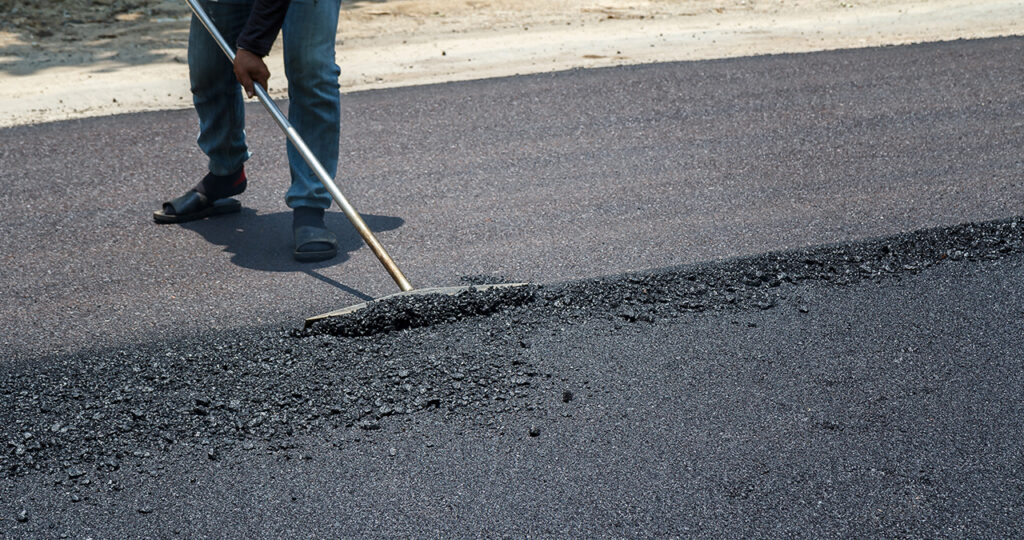Why Crack Sealing Matters
Cracks in pavement may seem minor at first, but if left untreated they can quickly lead to deeper structural damage — potholes, base failures, and costly repairs. According to research, 75% of unsealed cracks develop into potholes within three years, whereas properly sealed cracks show only ~1% progression to potholes in the same timeframe.
By performing crack sealing early, you prevent moisture and debris from entering the cracks, extend pavement life by 3-5 years, maintain smoother surfaces and ensure safer driveways or parking lots.
When to Perform Crack Sealing
Timing matters. For best results:
- Choose spring or fall when temperatures are moderate — cracks are not fully closed (as in summer) nor fully open (as in winter).
- Make sure pavement temperature is above the minimum threshold (many manufacturers recommend ~40°F or ~4-5°C) to guarantee good adhesion.
- Avoid sealing when crack density is high (e.g., over ~20% of surface area) or when the pavement shows signs of advanced distress (like alligator cracking) — in those cases, a more substantial repair or overlay may be required.
Step 1: Surface & Crack Preparation
Proper preparation is the foundation for effective crack sealing. Key steps:
- Routing: Consider routing (cutting a reservoir) to widen and deepen difficult cracks. This helps in better adhesion and longer life of the sealant.
- Cleaning: After routing (or when no routing), clean the crack thoroughly:
Step 2: Sealant Selection and Material Preparation
Choosing the right sealant and using it correctly are crucial.
- Choose a sealant based on: pavement condition, expected thermal movement, climate, and service life required.
- For colder climates (where large seasonal temperature swings exist): use a more flexible sealant. Hot-climate pavements may get away with stiffer sealants because the movement is less.
- For working cracks (those that move more than ~3 mm) use a sealant engineered for movement.
- When melting sealant blocks:
- Follow manufacturer’s specified temperature range (often ~380-410 °F / ~193-210 °C). Over-heating degrades properties; under-heating reduces flow and adhesion.
- Avoid reheating the same material multiple times; most sealants are only rated for one reheat cycle.
- Maintain agitation in the melter, load properly, and avoid mixing sealant types in the same tank unless fully cleaned out.
- Follow manufacturer’s specified temperature range (often ~380-410 °F / ~193-210 °C). Over-heating degrades properties; under-heating reduces flow and adhesion.
Step 3: Application Methods & Best Practices
Correct application ensures optimal performance. Some best practices include:
- Choose the right application configuration: flush fill, overband, reservoir or combination.
- Flush fill: fills the crack so sealant is flush with pavement surface. Ideal if a surface treatment or overlay is planned soon.
- Overband: the sealant is applied in & over the crack (often using a sealing disc) and then either left or shaped with a squeegee to ~⅛ inch thick and 2-4 inches wide. Good when edges are deteriorated.
- Reservoir: when routed, the reservoir holds the sealant below or flush with pavement, allowing for thermal movement.
- Flush fill: fills the crack so sealant is flush with pavement surface. Ideal if a surface treatment or overlay is planned soon.
- Fill from the bottom up: ensure full penetration of the crack; use the right wand tip.
- Avoid excessive application: drips, puddles or over-banding more than needed can reduce skid resistance and look unprofessional. Use a drip-stopper tip.
- On sloped pavements: if sagging of sealant occurs after cooling, select a higher-viscosity sealant to resist flow.
Step 4: Curing & Traffic Return
- Traffic shouldn’t be allowed too early — curing depends on sealant type, pavement & air temperature, and traffic volume
- Use of de-tacking agents or fine sand may allow traffic sooner, but check manufacturer instructions.
Step 5: Post-Job Inspection & Maintenance
- Once done, inspect the work for sealant height, clean edges, absence of drips or puddles.
- Document the linear feet of cracks sealed, the type of sealant used, ambient temperature, and any routing performed.
- Plan for periodic inspections: sealed cracks still need monitoring to ensure the surrounding pavement remains sound.
- If crack density increases significantly (>20% of surface) or alligator cracking appears, a full resurfacing might be more cost-effective than repeated sealing.
Why Using Professionals Makes a Difference
While DIY crack-sealing may seem attractive, improper routing, insufficient cleaning, wrong sealant choice or incorrect application can lead to premature failure and increased long-term cost. As one expert said:
“Errantly applied sealant … can cost road owners hundreds or even thousands of dollars a year.”
Your driveway, parking lot or commercial pavement is a major investment — entrusting it to experienced professionals ensures correct specification, high-quality application and extended pavement life.
FAQs & Local Considerations (New York & North-East)
Q: Can we crack-seal in winter in New York?
A: Generally no. Pavement temperature below ~4-5 °C and cracks fully open make adhesion poor, and routing may not even be viable. Best seasons are spring/early fall.
Q: My asphalt driveway is showing “alligator” cracking — is crack sealing still appropriate?
A: Not typically. Alligator cracking indicates structural failure — asphalt or base layers may be compromised. A full repair or overlay is more appropriate.
Q: How much extra life can crack-sealing add?
A: When done properly, it can often extend pavement life by 3-5 years, reduce maintenance costs, and delay major resurfacing.
Final Takeaway
Crack sealing is one of the most cost-effective pavement preservation treatments when done correctly, at the right time, and with proper materials. By following best practices — preparation, correct material, proper application and curing — you achieve long-lasting results.
If you’re in New York (or the broader metro-area) and want to preserve your driveway, parking lot or asphalt surface with trusted professionals, contact AMR New York today for a free inspection and quote.
Additional Reads:
Your Guide to Sealcoating Safety: Top 6 Seal Coating Tips
